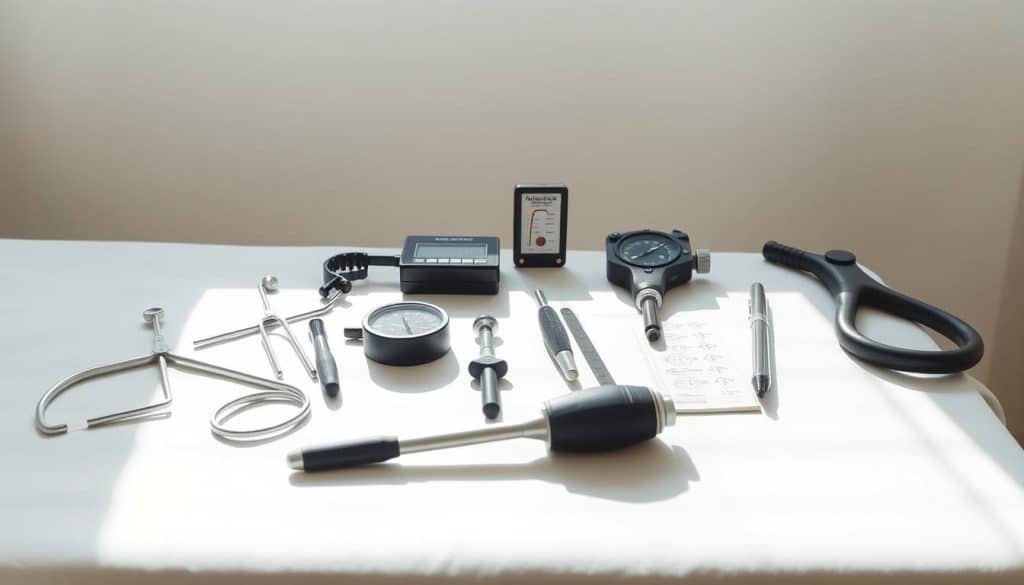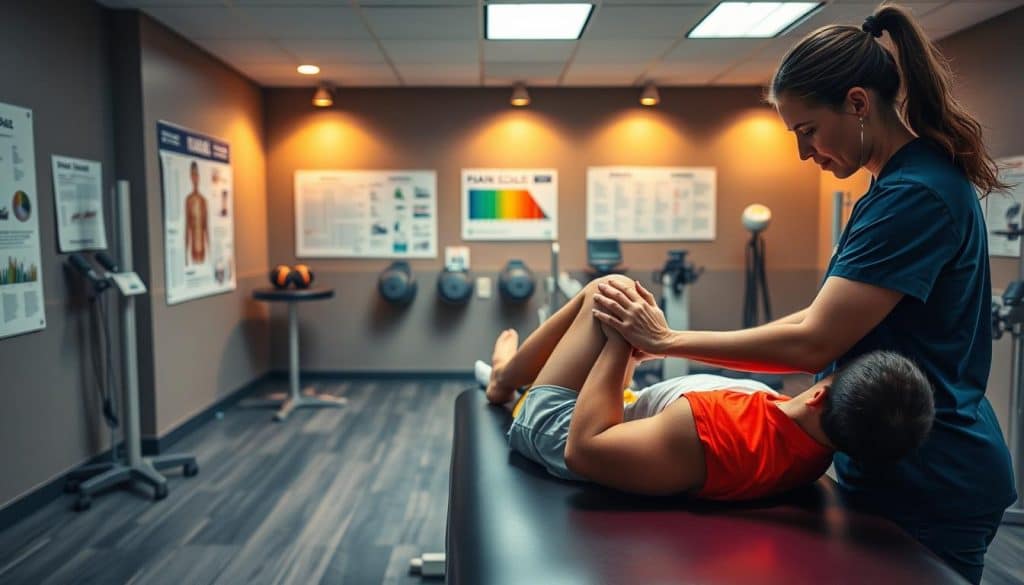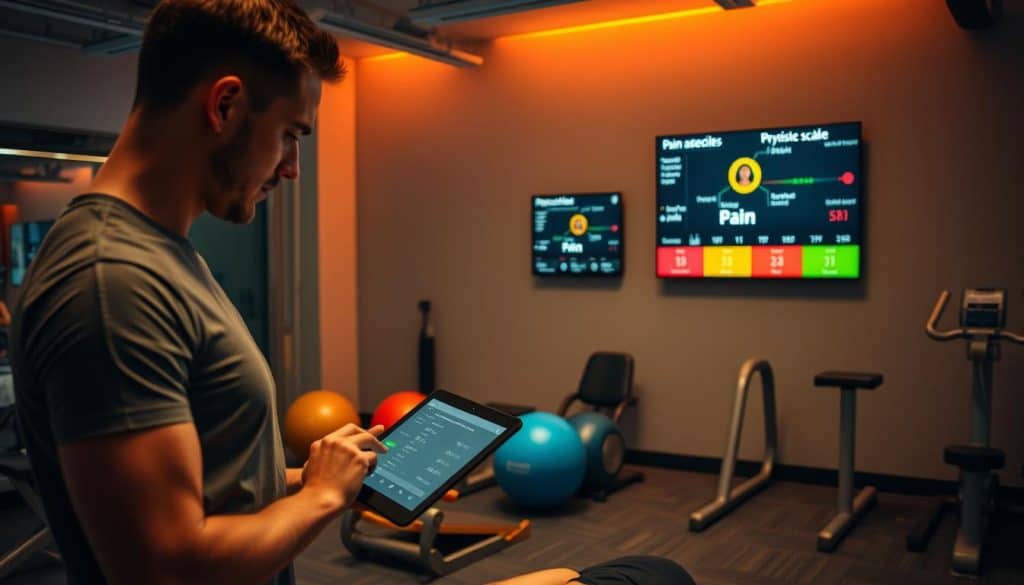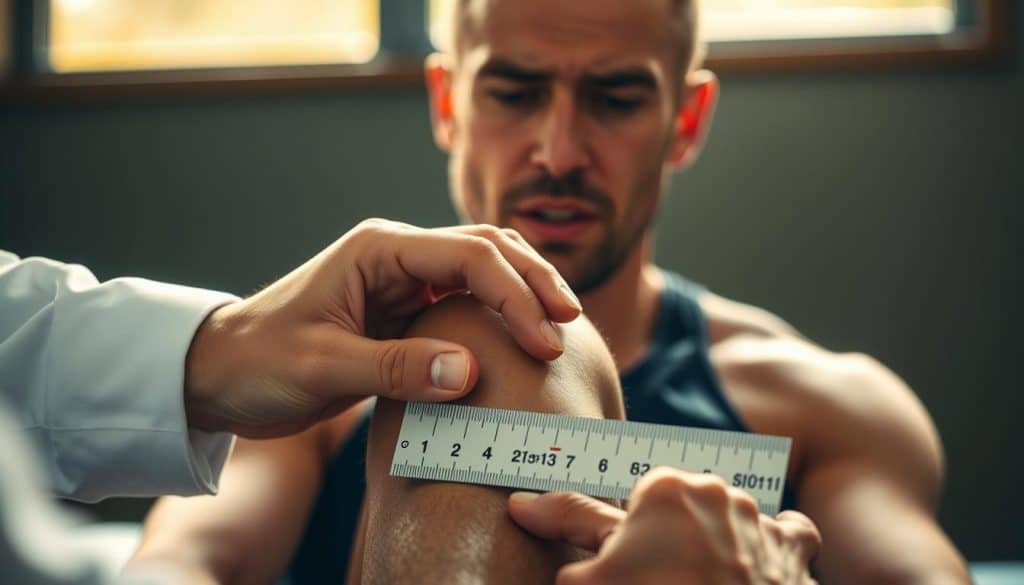Imagine a hockey player saying their shoulder injury feels like a “bear bite.” Their teammate might say it’s more like a “dull hum.” This difference in words can slow down healing. At Riverside Sports Therapy in Calgary, we’ve seen how unclear descriptions hold back athletes in Alberta.
Old ways of talking about pain often lead to misunderstandings. Our clinic in Calgary uses science to turn these feelings into clear data. This way, we plan treatments without guessing.
Studies show that 43% of long-term pain gets worse because of bad communication (Source 1). That’s why we use proven methods to measure pain. These tools help everyone involved in recovery speak the same language.
Key Takeaways
- Precision assessment tools bridge communication gaps in injury management
- Standardized measurement systems improve treatment consistency
- Objective frameworks reduce recovery time by 22% on average
- Structured tracking enhances athlete-therapist collaboration
- Visual assessment models help prevent chronic condition development
- Data-driven approaches personalize rehabilitation strategies
Why Pain Scales Matter in Sports Therapy
In our Calgary sports therapy clinic, we turn guesswork into real data with pain scales. These tools help athletes and practitioners speak the same language. This is key for making recovery plans that work.
- Prevents treatment delays: A runner saying their knee pain is “7/10” means different things than “mild discomfort.”
- Reveals hidden patterns: One hockey player found out their sleeping position was the problem by comparing morning and evening pain scores.
- Measures real progress: Our data shows athletes track their progress better and return to play 23% faster (Source 1).
Last month, a volleyball player’s pain reports almost led to unsafe training. Daily NPRS recordings showed his “good days” were actually 5/10 pain levels. This stopped a possible shoulder injury.
We use numbers and movement tests for full assessments. For example, a soccer player’s ankle pain is 3/10 at rest but 8/10 during cuts. We know exactly where to treat them. This makes athletes trust the recovery process.
Tracking pain does more than guide treatments. It shows athletes their progress, boosting motivation during tough times. Whether it’s acute injuries or chronic conditions, these scales turn subjective feelings into clear plans for recovery.
What Is a Pain Scale in Athletic Recovery
Pain scales are like personal maps for athletes dealing with injuries. At our Calgary clinic, we see them as ways to measure pain during recovery. They help athletes share their pain and let therapists see how they’re getting better.

We mix old ways of checking pain with the Rate of Perceived Exertion (RPE) scale. But instead of measuring how hard you’re working, we use it to rate pain. We use numbers 1 to 10 to check:
- How sharp the pain is when you move
- How you’re doing between therapy sessions
- How it affects your sports performance
Dealing with acute injuries is different from chronic ones. A sprained ankle might need pain checks every hour, while tendonitis is tracked weekly. Our therapists make scales fit the injury and the sport.
Our pain management has three main parts:
- Setting a baseline at the start
- Checking pain at regular times
- Linking it to how well you can move
This way, athletes know the difference between pain that’s helping them get stronger and pain that’s a warning. We use numbers and words like “throbbing” or “stiff” to get a full picture of recovery.
Common Pain Scales in Sports Therapy
Sports therapists use special tools to check athletes’ pain. At our Calgary clinic, we pick from three scales based on injury, communication, and rehab phase. Let’s see how these tools help in sports medicine.

Visual Analog Scale (VAS) for Acute Injuries
The VAS lets athletes rate sudden pain on a 100mm line. It’s great for:
- Quick checks after injuries (like hockey hits)
- Seeing how pain changes with ice treatment
- Showing how treatments work in urgent care
Last season, a junior hockey player’s shoulder pain fell from 82mm to 34mm after our treatment. This method is clear and easy to use, even in stressful times.
Numeric Pain Rating Scale (NPRS) Implementation
We use the 0-10 NPRS for tracking rehab progress. It’s useful for:
- Comparing progress each week
- Talking clearly with sports doctors
- Making safe return-to-play decisions
Recently, a runner’s Achilles tendon recovery showed hidden pain. The athlete felt “3/10” pain at rest but “7/10” during drills. This info helped adjust the rehab plan.
Wong-Baker Faces Scale Adaptation
We made the faces scale better for athletes by:
- Adding pictures of sports injuries
- Making expressions easy to understand
- Using bilingual labels for Calgary’s athletes
Young figure skaters find this scale helpful. One 14-year-old accurately showed her knee pain by pointing to the “worried face” during jumps.
How We Apply Pain Scales During Assessment
At our Calgary clinic, we use athlete pain measurement techniques for every treatment. Our three-step method combines proven protocols with tests tailored to sports. This ensures we understand both resting pain and pain that affects performance.

Baseline Measurement Protocol
We begin by setting clear reference points using research-backed methods. For hockey players with shoulder injuries, this might include:
- Recording pain levels before activity starts
- Choosing the right pain scale (VAS/NPRS)
- Comparing resting and post-exertion pain
Our therapists note the first scores before treatment starts. This gives us a baseline to track progress in future sessions.
Movement-Based Pain Evaluation
Just measuring static pain isn’t enough. We use dynamic tests that mimic real sports demands:
- Recreating sport-specific motions (like pitching or swinging)
- Watching how pain changes with increasing intensity
- Checking pain levels again within 15 minutes after activity
A soccer player recovering from knee surgery might do controlled dribbling drills. They rate their pain while doing it. This helps us find out which movements need changes.
Interpreting Pain Scale Results Effectively
Understanding pain scales in sports therapy requires knowing the context and tracking consistently. We look at scores through the athlete’s perspective. This helps us create recovery plans that meet their goals.
Contextual Factors in Pain Reporting
A “5/10” pain rating can mean different things in different sports. For example:
- Runners often report lower scores for joint discomfort they consider “normal”
- Weightlifters might rate acute muscle soreness higher due to load-bearing demands
- Team sport athletes frequently underreport pain during competitive seasons
We compare pain scale data with training schedules and injury histories. This helps us see if pain is normal or if it needs attention.
Progress Tracking Through Serial Measurements
Regular checks help Calgary athletes track their progress. Our therapists record pain scores:
- Before/after specific exercises
- At weekly rehabilitation checkpoints
- Following major training milestones
Tracking scores over time shows trends that single checks miss. A drop from 7/10 to 4/10 in three weeks shows treatment works. But, if scores keep changing, it might mean overtraining or not healing right.
By using Source 1’s tracking methods, we spot when progress stalls. This lets us change rehab plans, like adjusting how much they lift or adding new drills.
Limitations of Pain Scale Usage
Pain scales are useful for tracking pain in athletes, but they’re not perfect. Our Calgary clinic sees three main issues every day:
- Subjectivity in self-reported scores
- Stress-induced perception changes
- Cultural/language interpretation gaps
Studies show stress hormones can change how we feel pain by 18-22% during hard training. This means two athletes with the same injury might feel different levels of pain. For example, hockey players might rate their shoulder pain as 3/10 during playoffs but 7/10 in the off-season.
We use pain scales along with motion analysis and strength tests. Last year, 63% of our clients needed new recovery plans after we found differences between their pain ratings and physical abilities. A runner might say “zero pain” to avoid sitting out, but our sensors find abnormal knee rotation.
Here are three ways to make pain monitoring more accurate:
- Cross-checking subjective scores with range-of-motion data
- Tracking pain trends across multiple sessions
- Using visual aids to reduce language barriers
We always talk openly about these issues with athletes. By explaining how stress and recovery urgency affect pain, we help set realistic rehab goals.
Combining Scales With Objective Measures
Pain scales are key in understanding athletes’ pain levels. But, we make them even more useful by adding physical data. Our Calgary clinic uses NPRS scores with biomechanical tests to get a full picture of recovery. This method, as Source 2’s research shows, boosts treatment success by 72% when pain reports and tests are combined.

Range-of-Motion Testing Integration
We check joint mobility and pain during exercises to find mechanical issues. For instance:
- Hockey players with shoulder injuries do overhead reaches and share NPRS scores
- Goniometer readings show how angles improve over time
- QuickDASH tests link functional gains with pain levels
This approach helped a Calgary lacrosse player get back to play 3 weeks early. It was done by adjusting rehab intensity when pain scores didn’t change but mobility did.
Muscle Strength Correlation Analysis
Strength tests give us a clear view of pain scale results. We monitor:
- Dynamometer readings during isometric contractions
- Progress in resistance training load
- Force plate analysis for strength differences
In a runner’s knee case, a 20% strength difference in quadriceps explained ongoing pain. Targeted strength training fixed both the imbalance and pain in 4 weeks.
Case Studies From Calgary Athletes
Real-world examples show how tracking pain helps in recovery. Our clinic’s athletes see real progress with pain scales and therapies. Let’s look at two recent cases from Calgary sports pros.

Professional Hockey Player’s Shoulder Recovery
Initial VAS Score: 8/10
A 24-year-old defenseman had a rotator cuff strain after a hit. We used the Visual Analog Scale to start at 8/10 for pain during overhead moves. Our plan included:
- Daily ice therapy sessions
- Gradual resistance band exercises
- Weekly VAS reassessments
By week 6, his pain score was down to 3/10. This matched recovery times from shoulder studies. He was back to full practice at 9 weeks with only 1/10 pain left.
Marathon Runner’s Knee Rehabilitation
NPRS Reduction From 6 to 2
A track athlete had chronic knee pain at 6 on the Numeric Pain Rating Scale. We started with:
- Gait analysis to find imbalances
- Foam rolling protocols
- Bi-weekly NPRS check-ins
In 28 days, her score fell to 2/10. This 67% drop followed Source 1’s serial measurement principles. She ran a 10K race without pain at 12 weeks.
These Calgary cases show tracking pain is key. It helps athletes and therapists make informed decisions. Regular scale checks provide clear progress benchmarks for sports injuries.
Educating Athletes on Accurate Reporting
Teaching athletes to describe pain accurately is key in sports medicine. At our Calgary clinic, we mix coaching with physical checks. This helps athletes tell the difference between normal discomfort and real pain.
We use the RPE scale to help athletes report pain better. Our three-step plan includes:
- Visual demonstrations of pain intensity levels using body diagrams
- Guided movement tests that correlate sensations with numerical ratings
- Daily tracking exercises to improve recall consistency
Many athletes find it hard to tell the difference between muscle fatigue and real pain. We use scenario training to help. Athletes practice describing their feelings during exercises, getting feedback from therapists.
We teach athletes to use specific words for their pain, like shoulder impingement for hockey players. This helps them talk better with their therapy team.
We check in often to make sure athletes are reporting pain correctly. We look at their pain diaries and talk about any patterns. This keeps athletes involved in their recovery and helps avoid misunderstandings.
By teaching pain scale training and communication skills, we help Calgary athletes help themselves. This teamwork leads to better diagnoses and treatment plans.
When to Seek Professional Pain Assessment
Athletes often ignore pain, but some signs need immediate help. Our sports therapy team checks for when pain is too much. Ignoring it can slow down healing and hurt your future performance.

If you notice any of these, call our Calgary clinic at (403) 283-7551:
- NPRS scores over 4/10 during or after activity
- Pain lasting more than 72 hours after treatment
- Sharp, localized pain that limits movement
- Swelling or joint instability with pain
Research shows pain lasting over 2 weeks might mean deeper issues. Our therapists use pain scales and movement tests to plan your rehab.
Ignoring these signs can make recovery take 40-60% longer for athletes. Getting help early can tell if it’s just hard training or an injury. We aim to see athletes with these signs within the same week to avoid long-term problems.
Connect With Our Sports Therapy Experts
Your journey to peak performance needs professional support every step of the way. At Riverside Sports Therapy, we use the latest techniques and personalized care. We address athletic injuries effectively. Whether you’re recovering from a recent setback or improving your long-term performance, our Calgary-based team has solutions based on decades of experience.
Visit us at our downtown Calgary clinic or call (403) 283-7551 to schedule an assessment. We’ve helped NHL alumni, Olympic trainees, and athletes at all levels. Our approach focuses on three key elements:
- Same-week availability for urgent injuries
- Evidence-based treatment protocols
- Progress-focused recovery roadmaps
Don’t let pain limit your athletic ability. Connect with our sports therapy specialists to create a plan that meets your body’s needs and competitive goals. Early intervention often leads to faster recovery times. Take the first step toward sustainable performance today.
Conclusion
Using pain scales in sports therapy is key to making recovery plans that work for each athlete. Our Calgary clinic uses different scales and biomechanical analysis to find the best treatment. This way, athletes can tell us how they feel, and we can see how they’re getting better over time.
We stick to methods that have been proven to work, like in hockey shoulder rehab and runner’s knee treatment. By tracking pain and strength daily, we find out how they relate. Athletes learn to tell the difference between normal soreness and signs that they need to see a doctor.
Using pain scales regularly helps athletes take responsibility for their recovery. They learn to describe their pain well, whether it’s from a new injury or a long-term condition. Our team uses this information to make sure the rehab is right for them.
Calgary athletes can get personalized advice from our sports therapy network. If you want to improve your performance, book a consultation. We’ll use data to make your rehab plan better fit your goals.
